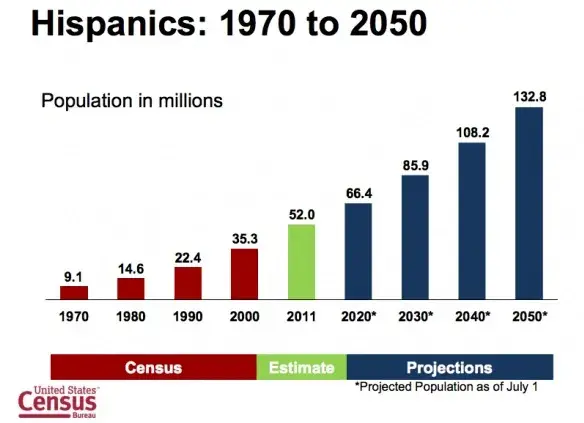Why should you be targeting the Hispanic population?
Compiled by Cynthia Penovi
This article is mainly a compilation of extracts from the 59-page analysis by Tamara Cabrera titled The Translation and Interpreting Industry in the United States. For more information and a complete list of references, read her analysis here.
- Your business will grow and distinguish itself from the competition.
According to a survey of Fortune 500 companies by Common Sense Advisory –a global think tank that performs research on international communication trends–, companies that translate their online material were found to be 1.5 times more likely to experience an increase in revenue. When you become able to speak to more of these users, you gain the competitive advantage.
- Hispanics are the fastest growing population in the U.S.
According to a Pew Research Center analysis of the Census Bureau’s American Community Survey, between 1970 and 2014 the Hispanic population grew 592%, expanding from 9.1 million to 53 million (Krogstad 2014). According to the most recent US Census data, by April 2015, there were 57 million U.S. Hispanics out of a total population of 321 million Americans (Krogstad 2016), accounting for a 17% of the total population. The Pew Research Center forecasts that the Hispanic population will grow to 106 million out of 398 million, and to 119 million by 2060 (Passel and Cohn 2008) This projected shift would raise the number of Hispanics from 17.8% to over a quarter of the total U.S. population by 2020, then up to 26.6% by 2050 and then up to 31% by 2060 (Krogstad and López 2014).
Numbers of Spanish Speakers in the U.S. Pew Research Center and U. S. Census Bureau:

- Hispanics are the largest minority in the U.S.
Hispanics are the largest minority in the US, outnumbering African-Americans (45 million). According to Nielsen, a global information and measurement company: “If U.S. Hispanics were a country, (…) they would be the 24th largest nation in the world after Italy larger than Spain and more than twice the size of Australia” (Pardo and Dreas 2011: 1).
- The U.S. is now the world’s second largest Spanish-speaking country (ibid.; Fernández Vítores 2016).
This puts the U.S. ahead of Colombia (48 million) and Spain (46 million) and second only to Mexico (121 million).
- Spanish is the most spoken non-English language in the U.S., with more than 41 million native speakers plus 11 million who are bilingual.
- Hispanics rank the highest among the LEP population.
“LEP” stands for “Limited English Proficiency”, and this term refers to any person above the age of 5 who reported speaking English less than very well, as classified by the Census Bureau. As of 2013, 16.2 million LEP people spoke Spanish, out of 25.1 million total approximately.
- Laws are changing in favor of language access for Hispanics and the LEP population.
Hispanics have become the main recipients of the translation and interpreting services implemented as result of the enforcement of Language Access legislation (namely (i) the Title VI of the Civil Rights Act of 1964, (ii) the LEP Executive Order and (iii) the LEP Guidances 2002).
- The Hispanic buying power alone makes the Hispanic market within the U.S. one of the most important World Economies.
U.S. Hispanics’ disposable income has sextupled between 1990 and 2014, reaching an estimated $1.25 trillion in 2014. This makes up approximately a 10% of total U.S. buying power. As of 2014, the buying power of U.S. Hispanics was 1.3 trillion dollars higher than that of other minorities (African-American, $1.1 trillion and Asians $770 billion) (López et al. ibid.). As suggested by Pardo and Dreas (2011: 1): “If U.S. Hispanics were a country, they would rank as the 12th largest economy in the world.”
- Hispanics are the population of the future and the community you will be serving.
According to The Economist (2015: 2) Hispanics are making America much younger. In fact, the median age of whites is 42, African-Americans 32, Hispanics 28, and American-born Hispanics 18. While white and non-white women have been having fewer children since 2011, Hispanic women’s fertility maintains an average of 2.4 children, expected to replenish the supply of future workers.
- Hispanics are the entrepreneurs of the future –and your future business partners.
The number of Hispanic-owned companies has been steadily growing since 2002. Estimates from the 2007 Survey of Business Owners conducted by Geoscape, a leading business intelligence firm that operates within the framework of the U.S. Hispanic Chamber of Commerce, shows that from 2002 to 2007 the number of Hispanic-owned firms increased by 44%. This figure is more than double the 15% increase in the number of non-Hispanic companies. Between 2007 and 2015, the growth rate has increased to a 57% as a result of the increased activity in entrepreneurship among Hispanics, a gain of over 407 million dollars (Melgoza and Palomares 2015: 3).
Number of Hispanic-Owned Businesses in the U.S. Source: Melgoza and Palomares (2015: 1):
- Language plays a key role in Hispanic culture and identity.
U.S. companies are spending money researching effective techniques to tap on this market (Hoag 2015). If in 2003 companies such as Procter&Gamble or AT&T spent $3.4 billion on Hispanic campaigns, by 2013 that figure had almost tripled to $8.3 billion, far outpacing the general market’s increase. According to the second-quarter 2012 Nielsen Report titled State of the Hispanic Consumer: The Hispanic Market Imperative (Nielsen 2012), Hispanic consumers are 30% more likely to recall an ad if it was presented in Spanish. Furthermore, 71% of Hispanics are more likely to buy a product if it is advertised in Spanish. Suggested reasons for this effect are that Spanish ads create a deeper personal connection to Hispanic consumers, and Hispanics are less likely to time shift Spanish-language programming (Taylor et al. 2012). This explains why U.S. companies are increasingly interested in adapting their products to the Hispanic consumer, both linguistically and culturally. The demographic growth of U.S. Hispanics and the high retention rate of Spanish in households have contributed to the growth of the Spanish Language in the U.S. Unlike other immigrant groups, Hispanics believe it is highly important to preserve the language and the culture. As a result, they tend to preserve the language and the culture far beyond other groups, such as European migrants. A study developed in 2013 found that by third generation, only a small number of Europeans maintains bilingualism (Steinmetz et al. 2015: 17.). In contrast, the percentage of Hispanic households that spoke Spanish remained consistently at about 75% from 1980 to 2010 (Hugo López and González-Barrera 2013).
Tamara Cabrera’s analysis is enlightening and very useful to understand the current trends in the U.S. and why it would be beneficial to invest in translation services, no matter what your industry is. The Hispanic population has become a key market, and professional translators are the only experts with the necessary cultural and linguistic background to reach this community effectively.





I’ve been browsing on-line greater than 3 hours as of late, yet I never found any fascinating article like yours. It’s pretty value sufficient for me. In my view, if all web owners and bloggers made just right content as you probably did, the net can be much more helpful than ever before. “A winner never whines.” by Paul Brown.
Awesome article.
Great article. I’m experiencing many of these issues as well..
Howdy! I’m at work surfing around your blog from my new iphone!
Just wanted to say I love reading through your blog and
look forward to all your posts! Carry on the fantastic work!
Thanks very nice blog!
Hi there! I simply wish to give you a huge thumbs up for your great information you’ve got right here on this post.
I’ll be returning to your site for more soon.
It’s really a cool and helpful piece of info. I am glad that you shared this helpful info with us.
Please keep us informed like this. Thanks for sharing.
Incredible points. Sound arguments. Keep up the
amazing work.
Wow that was strange. I just wrote an very long comment but after I clicked submit my comment didn’t appear.
Grrrr… well I’m not writing all that over again. Anyways, just wanted to say
excellent blog!
Excellent article. I absolutely appreciate this website.
Keep writing!
Hi there! This is my first visit to your blog! We are a group of volunteers and starting a
new initiative in a community in the same niche.
Your blog provided us beneficial information to work on. You have done a extraordinary job!
Keep this going please, great job!
It’s a pity you don’t have a donate button! I’d without a doubt donate to this brilliant blog!
I guess for now i’ll settle for book-marking and adding your RSS feed to my Google
account. I look forward to fresh updates and will talk about this
blog with my Facebook group. Chat soon!
Terrific work! This is the kind of information that
should be shared across the web. Disgrace on the
search engines for now not positioning this put up higher!
Come on over and talk over with my web site . Thank you
=)
I really like what you guys are up too. This kind of clever work and coverage! Keep up the very good works guys I’ve included you guys to our blogroll.|